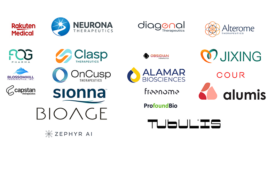
[ipopba/Adobe Stock]
In 2024, 72 late-stage therapies are poised for FDA approval, hinting at the potential for resurgence within the life sciences. While post-pandemic lab construction meets a wave of approvals, a slowdown in venture funding and job growth casts a temporary shadow. Additionally, the biotech lab space real estate picture is not as simple as it seems, with a marked shift in the scale and nature of drug development driving evolving space needs.
Even amidst this period of adjustment, investment levels still exceed pre-COVID-19 baselines. From 2008 to 2012, the average annual VC deployment in the U.S. clocked in at $7.6 billion. In 2023, VC funding totals blew past that level in only 3.5 months, even in what is considered a “down” market, as the JLL 2023 Life Sciences Industry and Real Estate Perspective noted. Promising new therapeutic areas such as those targeting obesity, metabolic disorders, and neurological diseases through modalities like GLP-1 agonists are garnering significant attention and could transform the industry’s landscape. This is exemplified by the 68% increase in obesity clinical trials in 2023 compared to 2022, nearly doubling when looking at a five-year span, according to IQVIA’s Global Trends in R&D 2024 report.
The hidden demand: Later-stage success fuels lab space needs
In biotech hotbeds like San Francisco, San Diego, and Boston, an oversupply of lab space is evident. Boston’s life sciences vacancy rate reached a 10-year high at 11.7% in Q3 2023. Similarly, the Bay Area and San Diego saw significant increases in vacant space throughout the year. By Q1 2023, San Diego’s vacancy rate doubled from its record low of 2.7%.

Travis McCready
The numbers are beginning to improve with later-stage companies with mature drug pipelines driving a quiet increase in demand, said Travis McCready, head of life sciences, Americas markets at JLL. “The problem is that this increase is largely obscured by the fact that we have so much supply.”
To put things in perspective, before 2022, there was virtually no market in the U.S. with a supply-demand imbalance greater than two to one, McCready said “At its peak in Q4 of 2023, in Boston, for example, the supply-demand imbalance ratio was 10 to one.” San Francisco found itself in a similar position. The sector has seen significant oversupply but is starting to see some improvement. Still, across U.S. markets, the supply-demand ratio has increased roughly 4 to 5 times compared to pre-2022 levels, McCready said.
This oversupply could partly reflect the decline of COVID-19 focused trials. As record-breaking enrollment in these trials has ebbed, sponsors are shifting their focus to areas like cardiovascular disease, oncology, and rare diseases.
The vast promise of next-gen metabolic therapies
One particularly bright spot in drug development is the vast potential of GLP-1 agonists and other next-gen metabolic therapies. The sheer magnitude of the global obesity crisis, with more than 3 billion people globally living with obesity, underscores the massive potential impact of these therapies on public health. Beyond obesity, GLP-1 agonists show surprising promise in conditions ranging from non-alcoholic fatty liver disease (NAFLD) to neurological conditions like Alzheimer’s and ALS. The treatments’ positive datasets for Alzheimer’s and ALS “was a fairly large scientific surprise,” McCready said.

[Data source: JLL/Nature/GlobalData]
Early-stage struggles, late-stage success
Amidst the apparent oversupply of lab space, some companies continue to thrive. The biotech landscape is evolving, with early-stage companies facing significant headwinds while late-stage players with promising clinical assets fuel demand.
The biotech sector sees layoffs hitting early-stage companies hard, as venture capital favors mature, clinically de-risked assets. But focusing on the layoffs alone is only one part of the equation. “I think it’s more prudent to invest in the concept of churn,” McCready said. “The layoffs remain pretty much flat,” he said, and are more often to affect cash-strapped startups with early-stage assets. Big Pharma companies retooling their strategy as the pandemic shifts to an endemic is another driver of churn.
This “tale of two cities” dynamic is underscored by the recent surge in M&A activity, with large pharma companies spending tens of billions on promising late-stage clinical assets. “The largest 20 pharma companies are sitting on record numbers of R&D budgets — over a trillion dollars, by some measures,” McCready noted.
With a wave of patent cliffs approaching, Big Pharma firms are driven to “restore their patent vaults,” McCready said. “They are choosing to do that with late-stage clinical assets.” This focus on late-stage assets further fragments the industry. “There is abundance in the market, but the abundance is less the story than the stark division between early-stage and late-stage clinical assets at the moment,” he added.
Biotech’s decentralized future: Building hubs beyond the hotspots
The current biotech landscape might initially appear contradictory, but viewing the biotech sector through the lens of short-term fluctuations can obscure, McCready points out. “Instead, appreciate the life sciences for what it is, which is a highly risky, scientific endeavor driven by scientific success,” he noted.
Success will depend not only on scientific discovery, but on a robust infrastructure to turn those breakthroughs into life-changing treatments. This requires the right mix of funding, facilities, and crucially, seasoned professionals capable of building large-scale biotech companies. A wave of emerging biotech hubs is emerging across the United States, from Baltimore to Las Vegas, could translate into increased biotech resilience and output. The National Science Foundation (NSF) shift towards funding upstream ecosystem creation aligns with this vision. “The NSF has shifted its strategy to focus less on just funding the best science… and more on funding upstream by creating the best ecosystems,” McCready said. “The idea is that if you create the necessary assets and concentrations of expertise and resources, great science will follow.”
Filed Under: Biologics, Biotech, Metabolic disease/endicrinology, Regulatory affairs



